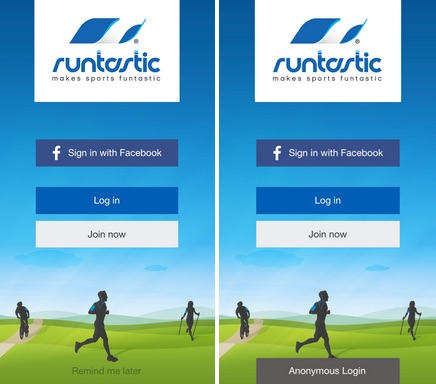Test if Facebook’s New Login is Right for Your App

Last week, we talked about Facebook’s new Anonymous Logins that are going to reshape the way developers onboard users. Integrating Facebook’s new technology will likely be a fairly complicated process for many teams. Developers will have to determine how to optimize their flow for the changes, as well as how to upsell their customers to a normal Facebook login. They’ll also have to test different a bunch of different new use cases, and will likely be subject to a 3-7 day Facebook review process in order to get the data integration benefits.
Before you jump at the chance to integrate this new technology, your team should make sure that the benefits outweigh the costs. If you’re not sure if Social or Anonymous Logins are right for your app, there’s a way to see if it hurts or helps using mobile A/B testing, using minimal resources and time.
This quick method will help you make an educated decision as to whether an anonymous login function would increase signups, conversions, and retentions, and determine the challenges with flow and review that would need to be addressed.
Using a visual editor will allow you to create, run, and get results from the experiment in as little as 1 week.
Simulating Facebook’s New Login
Facebook’s feature acts very similarly to the “Skip Registration” or “Remind Me Later” functions found in quite a few app login screens. These functions allow users to skip the login process, and immediately start using an application. The apps don’t collect any personal information unless the user decides to sign up for an account later in the process.

Since the skip function acts so similarly to Anonymous Login, we can use it to simulate the experience of having an Anonymous Login function to see how users react. Using a mobile A/B testing tool, create a variant of the login page with a skip function labeled “Anonymous Login,” and push it out to a percentage of your users. Then, track the appropriate metrics regarding bounces, logins, engagement, and conversions to determine its effectiveness. If you have significant lift in either variant, you’ll know which one is most effective for your app.
What we want to determine is whether having the a function “Anonymous Login” will decrease bounce rates, while raising overall engagement levels and conversions. You’ll also be able to see if users are willing to give over their personal information to sign up for an account after exploring your app.
Don’t Make This Mistake
One common mistake made for tests like this is only immediately affected metrics, in this case: the bounce and login rates. While those are important, you want to know how any changes introduced affect your application as a whole, as well as your KPIs.
Let’s say an eCommerce company drastically decreased their bounce rate by implementing an anonymous login feature. However, unbeknownst to them, the change actually led to a decrease in total sales. If the team didn’t track other metrics throughout the app such as engagement, items viewed, and most importantly, total sales, they might assume that the change is beneficial, when it may in fact be hurting their app.
To guard against this, developers should take care to track KPI events in different parts of their funnel, as well as immediately trackable actions.
- Conversions
- Login Clicks
- Sign Up Clicks
- Skip Button Clicked
- User Engagement Metrics: (Videos watched, points earned, notes taken, etc.)
- User Retention Metrics (who returns after 30, 60, 90 days)
- Users who register their account information later
Using this method and tracking the correct metrics will give you a good idea of how effective the new login process will be for you. Facebook’s login clearly has some great benefits, but all apps are different, and what works for other apps may not improve yours as well. The best way is to test changes and implement then when proven. Apptimize allows you to quickly iterate and improve your app, without being limited by the constraints of the app stores.
Thanks for
reading!
More articles you might be interested in:
7 Things to A/B Test in Your Mobile App
We hear from customers that planning out your second, third, and fourth A/B tests is one of the hardest things to. Many app managers have a first test in mind when they start experimenting and planning out a series of...
Read MoreInfographic: 7 Things to A/B Test in a Travel App
Our third infographic in the “7 Things to A/B Test” series! Click on the image below to see the full infographic.
Read MoreInfographic: 7 Things to A/B Test in a Gaming App
Knowing what to test the hardest part of getting started with A/B testing. This is why we created the “7 Things to A/B Test” series that began with the 7 Things to Test in a Retail App. Here is our...
Read More